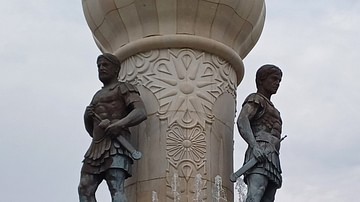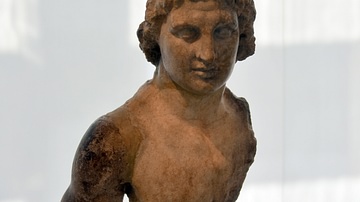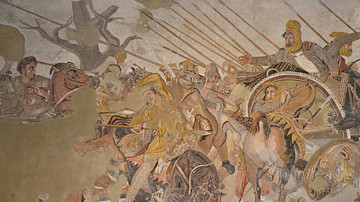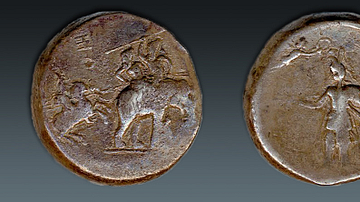Search
Search Results

Image
Colossal Statues of Philip II and Alexander III in Skopje
Colossal statues of Philip II of Macedon (r. 359-336 BCE) and Alexander the Great (r. 336-323 BCE) in Skopje. The Skopje 2014 (2010-2014) was a project involving the construction of 136 monumental buildings, bridges, statues, and fountains...

Image
Alexander the Great
Marble head of Alexander the Great, found in the Kerameikos in Athens, c. 300 BCE. Alexander wears the lion’s pelt, a common iconographic feature in depictions of the young king on coins, which hints at his descent from the mythical hero...

Image
Portraits of Alexander and a Youth (Hephaestion?)
Marble portraits of Alexander the Great and a youth, perhaps Hephaestion, Alexander's closest companion, c. 325-320 BCE. One of the earliest surviving portraits of Alexander. (Metropolitan Museum of Art, New York, on loan from the J. Paul...

Image
Statuette of Alexander the Great
This statuette once stood as a votive in the ritual chamber of the "Holy House" in Priene (Ionia Region, Turkey). The features of the statuette, as well as attributes like the flowing hair and emotional gaze, are strongly reminiscent of Alexander...

Image
Alexander the Great (Artistic Facial Reconstruction)
A photorealistic representation of Alexander the Great (r. 336-323 BCE) as he may have appeared in life. This reconstruction is based on archaeological evidence including busts, coin portraits and statuary, as well as descriptions of Alexander...

Image
Alexander the Great & Bucephalus Mosaic
Detail of the Alexander Mosaic, representing Alexander the Great on his horse Bucephalus, during the battle of Issus.

Image
Alexander the Great in Combat
An artistic impression of Alexander the Great in combat (played by Colin Farrell), from the motion picture Alexander (2004), directed by Oliver Stone.

Image
The Alexander Mosaic
The Alexander Mosaic, dating from circa 100 BCE, depicts the Battle of Issus (333 BCE) between Alexander the Great and Darius III of Persia. The mosaic adorned one of the exedras on the north side of the peristyle of the House of the Faun...

Image
Death of Alexander Clay Tablet
This is a diary of astronomical and meteorological phenomena observed during the 2nd month of the years 323-322 BCE. Written in cuneiform inscription, it records the death of Alexander on the 29th day of the lunar month. The author describes...

Image
Alexander & Porus
A rare silver medallion decadrachm depicting Alexander the Great on horseback attacking King Porus on elephant; the reverse shows the Macedonian king holding a thunderbolt while being wreathed by Nike Babylon (?), c. 325/4-322/1 BCE The...